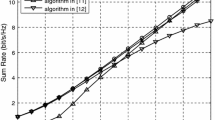Abstract
In this paper, a trade-off metric of unified energy efficiency (EE) and spectral efficiency (SE) is investigated in orthogonal frequency division multiple access downlink networks. The weighted product of the EE and SE of users is adopted to balance EE and SE. A maximization problem of the minimum weighted utility is formulated, and the original problem is divided into two sub-problems; one is a subcarrier allocation (SA) problem, and the other is power allocation (PA). For the SA problem, a sub-optimal algorithm employing a search method is utilized. To solve the PA problem, quasi-concavity of the utility function with respect to total transmit power in the PA sub-problem is shown. Based on the quasi-concavity, an iterative search algorithm of the optimal PA is developed. Through simulations, the efficiency of the algorithm is examined.




Similar content being viewed by others
Notes
Because bandwidth B is a common factor in both SE and EE, it can be ignored in discussions on the trade-off between SE and EE.
\(\mathcal {A}\) denotes a set of subcarriers which are not allocated to any user in a given iteration, \({\mathcal {S}}^k\) is a set of subcarriers allocated to the kth user.
Without this step, no subcarrier can be allocated to some users in the process of the iterative algorithm.
In the algorithm, \(I_{max}\) is the maximum number of iterations, \(\epsilon _{t}\) denotes convergence tolerance of the outer loop, and \(t_l\) and \(t_u\) are low and upper bounds of t.
References
Amin, O., Bedeer, E., Ahmed, M., & Dobre, O. (2015). Energy efficiency–spectral efficiency trade-off: A multiobjective optimization approach. IEEE Transactions on Vehicular Technology,. doi:10.1109/TVT.2015.2425934.
Boyd, S., & Vandenberghe, L. (2004). Convex optimization. New York: Cambridge Unversity Press.
Ning, C., Hsu, H. S., & Lin, P. (2011). Joint subcarrier pairing and power allocation for OFDM transmission with decode-and-forward relaying. IEEE Transactions on Signal Processing, 59(1), 399–414.
Deng, L., Rui, Y., Cheng, P., Zhang, J., Zhang, Q. T., & Li, M. (2013). A unified energy efficiency and spectral efficiency tradeoff metric in wireless networks. IEEE Communications Letters, 17(1), 55–58.
Jing, W., Lu, Z., Wen, X., Hu, Z., & Yang, S. (2015). Flexible resource allocation for joint optimization of energy and spectral efficiency in OFDMA multi-cell networks. IEEE Communications Letters, 19(3), 451–454.
Li, Z., Jiang, H., Pan, Z., Liu, N., & You, X. (2015). Energy spectral efficiency tradeoff in downlink OFDMA network. International Journal of Communication Systems, 28(8), 1450–1461.
IEEE 80216 Broadband Wireless Access Working Group (2003-06-27) Channel models for fixed wireless applications. In IEEE 802.16a-03/01.
Rhee, W., & Cioffi, J. (2000). Increase in capacity of multiuser OFDM system using dynamic subchannel allocation. In Proceedings of the IEEE VTC-Spring, Tokyo, Japan (Vol. 2, pp. 1085–1089).
Seong, K., Mohseni, M., & Cioffi, J. (2006). Optimal resource allocation for OFDMA downlink systems. In Proceedings of the international symposium on information theory (ISIT), Seattle, WA (pp. 1394–1398).
Song, Z., Ni, Q., Navaie, K., Hou, S., & Wu, S. (2015). Energy- and spectral-efficiency tradeoff with \(\alpha\)-fairness in downlink OFDMA systems. IEEE Communications Letters, 19(7), 1265–1268.
Wang, S., Feng, C., Guo, C., & Wang, G. (2014). Efficiency and fairness aware resource allocation for energy and spectrum in downlink OFDMA systems. Electronics Letters, 50(5), 411–413.
Xiong, C., Li, G., Zhang, S., Chen, Y., & Xu, S. (2011). Energy- and spectral-efficiency tradeoff in downlink OFDMA networks. IEEE Transactions on Wireless Communications, 10(11), 3874–3886.
Yu, W., & Lui, R. (2006). Dual methods for nonconvex spectrum optimization of multicarrier systems. IEEE Transactions on Communications, 54(7), 1310–1322.
Acknowledgements
This work was supported by the 2016 Yeungnam University Research Grant.
Author information
Authors and Affiliations
Corresponding author
Rights and permissions
About this article
Cite this article
Kim, S., Yu, H. Energy- and Spectral-Efficiency Trade-Off in OFDMA Downlink Channels. Wireless Pers Commun 96, 6355–6367 (2017). https://doi.org/10.1007/s11277-017-4481-z
Published:
Issue Date:
DOI: https://doi.org/10.1007/s11277-017-4481-z




